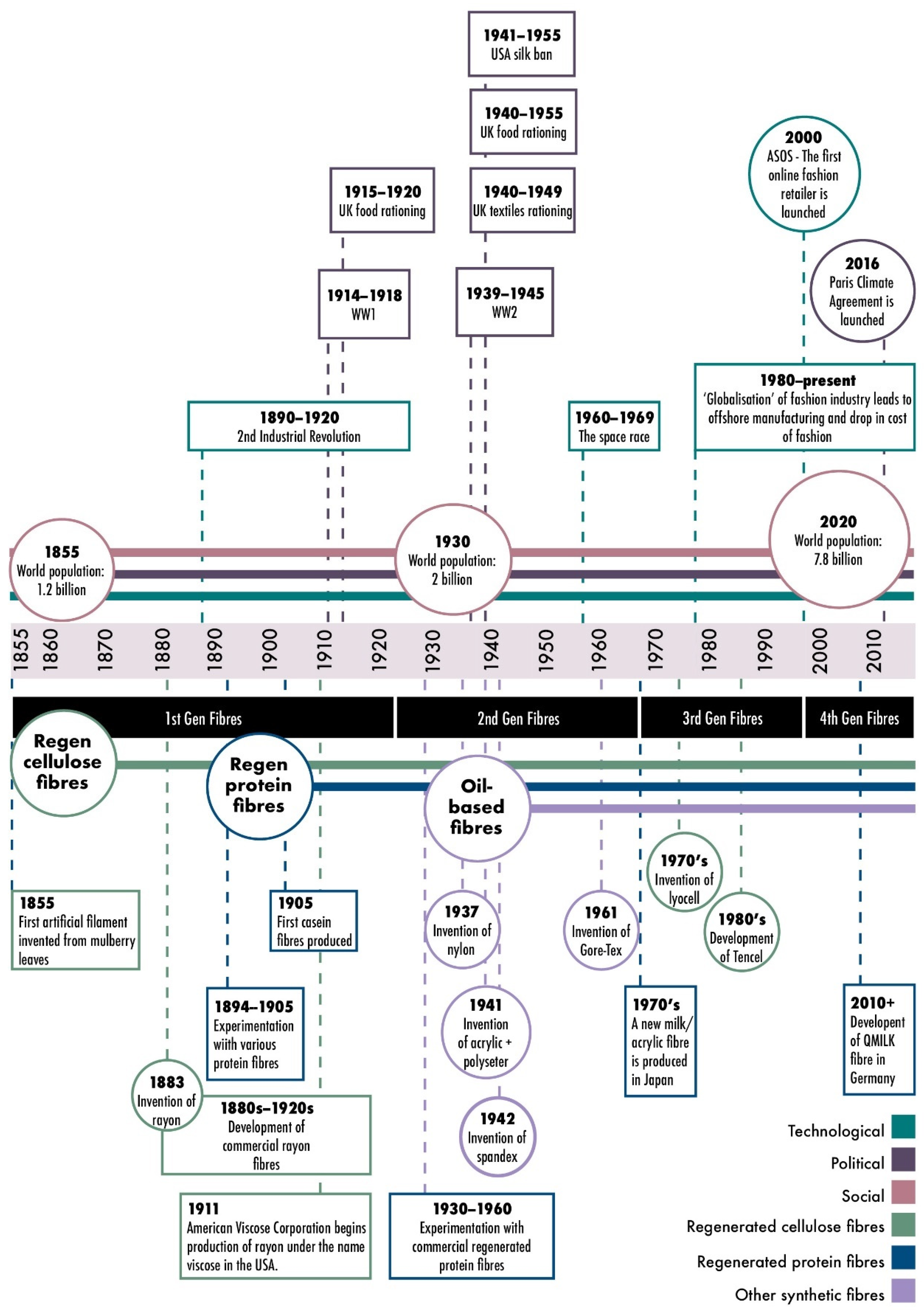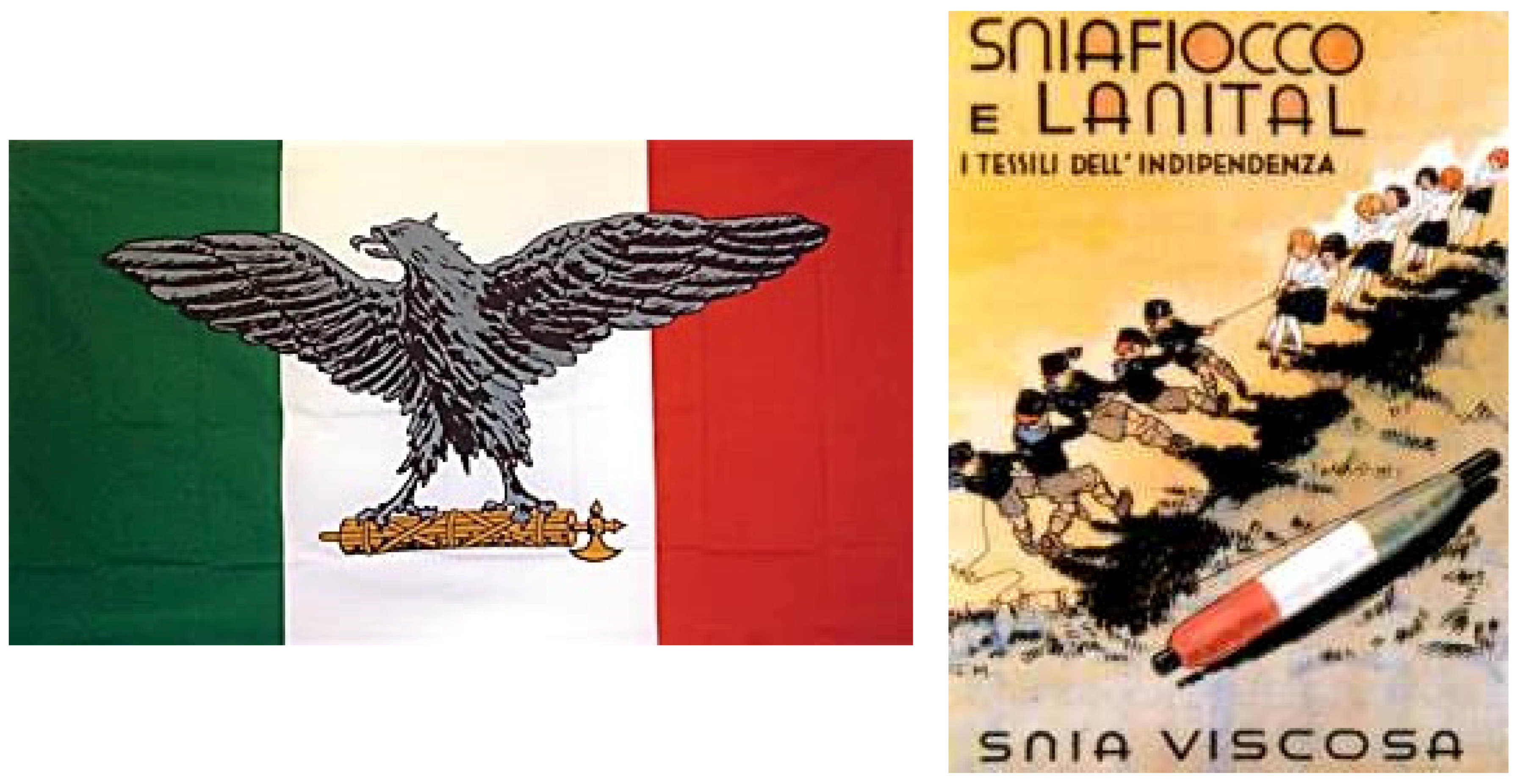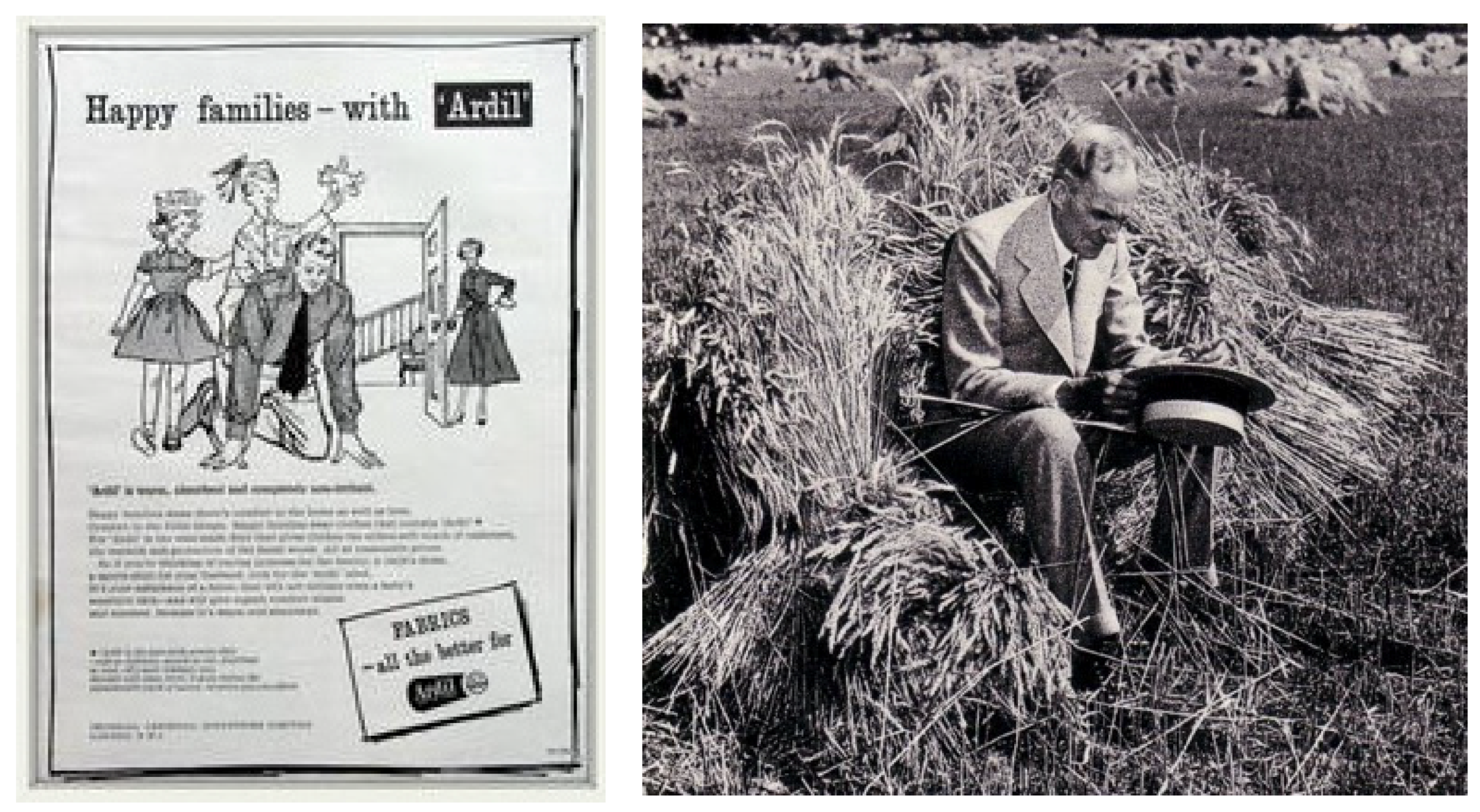The Potential for Regenerated Protein Fibres within a Circular Economy: Lessons from the Past Can Inform Sustainable Innovation in the Textiles Industry
Abstract
1. Introduction
2. Methods
3. Results
3.1. First Generation Fibres: 1855–1925
3.1.1. Socio-Political Context
3.1.2. Technology
3.1.3. Marketing
3.2. Second Generation Fibres: 1925–1970
3.2.1. Socio-Political Context
3.2.2. Technology
3.2.3. Marketing
3.3. Third Generation Fibres: 1970–2000
3.3.1. Socio-Political Context
3.3.2. Technology
3.3.3. Marketing
3.4. Fourth Generation Fibres: 2000–2021+
3.4.1. Socio-Political Context
3.4.2. Technology
3.4.3. Marketing
4. Discussion
Author Contributions
Funding
Institutional Review Board Statement
Informed Consent Statement
Conflicts of Interest
References
- The Textile Exchange. Preferred Fiber Materials Market Report. 2018. Available online: https://textileexchange.org/2018-preferred-fiber-reports (accessed on 21 October 2019).
- Sumner, M. Fixing Fashion: Clothing Consumption and Sustainability; House of Commons: London, UK, 2017. Available online: http://data.parliament.uk/writtenevidence/committeeevidence.svc/evidencedocument/environmental-audit-committee/sustainability-of-the-fashion-industry/written/88396.html (accessed on 25 February 2020).
- Boucher, J.; Friot, D. Primary Microplastics in the Oceans: Global Evaluation of Sources; IUCN: Gland, Switzerland, 2017; Available online: https://www.iucn.org/content/primary-microplastics-oceans (accessed on 25 January 2021).
- Sanchez-Vidal, A.; Thompson, R.C.; Canals, M.; De Haan, W.P. The imprint of microfibres in southern European deep seas. PLoS ONE 2018, 13, e0207033. [Google Scholar] [CrossRef] [PubMed]
- Global Fashion Agenda & Boston Consulting Group. Pulse of the Fashion Industry. 2017. Available online: https://globalfashionagenda.com/wp-content/uploads/2017/05/Pulse-of-the-Fashion-Industry_2017.pdf (accessed on 25 February 2020).
- WRAP. A Carbon Footprint for UK Clothing and Opportunities for Savings; WRAP: Banbury, UK, 2017; Available online: http://www.wrap.org.uk/sustainable-textiles/valuing-our-clothes%20?search_block_form=A+Carbon+Footprint+for+UK+Clothing+and+Opportunities+for+Savings (accessed on 12 December 2019).
- BoF. The Year Ahead: Sustainability Takes Centre Stage. 2020. Available online: https://www.businessoffashion.com/articles/intelligence/the-year-ahead-sustainability-takes-centre-stage (accessed on 25 February 2020).
- Braungart, M.; McDonough, W.; Bollinger, A. Cradle-to-cradle design: Creating healthy emissions—A strategy for eco-effective product and system design. J. Clean. Prod. 2007, 15, 1337–1348. [Google Scholar] [CrossRef]
- Ellen McArthur Foundation. Towards the Circular Economy Volume 1: An Economic and Business Rationale for an Accelerated Transition; Ellen McArthur Foundation: Cowes, UK, 2012; Available online: https://www.ellenmacarthurfoundation.org/assets/downloads/publications/Ellen-MacArthur-Foundation-Towards-the-Circular-Economy-vol.1.pdf (accessed on 12 November 2019).
- FAO. Global Food Losses and Food Waste: Extent, Causes and Prevention. In Food and Agriculture Organization of the United Nations Issuing Body; FAO: Rome, Italy, 2011. Available online: https://library.wur.nl/WebQuery/groenekennis/1982425 (accessed on 10 November 2019).
- FAO. Food Wastage Footprint: Impacts on Natural Resources. In Food and Agriculture Organization of the United Nations Issuing Body; FAO: Rome, Italy, 2013. Available online: http://parlinfo.aph.gov.au/parlInfo/search/summary/summary.w3p;query=Id:%22library/lcatalog/00701899%22 (accessed on 10 October 2019).
- WRAP. Quantification of Food Surplus, Waste and Related Materials in the Supply Chain; WRAP: Banbury, UK, 2016; Available online: https://wrap.org.uk/resources/report/quantification-food-surplus-waste-and-related-materials-supply-chain (accessed on 16 February 2021).
- Zhao, X.; Zhao, X.; Chen, J.; Chen, J.; Du, F.; Du, F. Potential use of peanut by-products in food processing: A review. J. Food Sci. Technol. 2012, 49, 521–529. [Google Scholar] [CrossRef]
- Shukla, R.; Cheryan, M. Zein: The industrial protein from corn. Ind. Crops Prod. 2001, 13, 171–192. [Google Scholar] [CrossRef]
- Nguyen, T.A.H.; Ngo, H.H.; Guo, W.S.; Zhang, J.; Liang, S.; Tung, K.L. Feasibility of iron loaded okara for biosorption of phosphorous in aqueous solutions. Bioresour. Technol. 2013, 150, 42–49. [Google Scholar] [CrossRef]
- Choi, I.S.; Kim, Y.G.; Jung, J.K.; Bae, H. Soybean waste (okara) as a valorization biomass for the bioethanol production. Energy 2015, 93, 1742–1747. [Google Scholar] [CrossRef]
- O’Brien, R. Wartime Textile Adjustments. J. Home Econ. 1942, 34, 512–514. [Google Scholar]
- Thompson, M. Rubbish Theory: The Creation and Destruction of Value; Pluto Press: London, UK, 2017. [Google Scholar]
- Brooks, M.M.; Rose, M. Contextualizing Textiles: Using Documentary Evidence to Retrieve Evidence for Regenerated Protein Fibres. Stud. Conserv. 2006, 51, 82–88. [Google Scholar] [CrossRef]
- Brooks, M.M. Regenerated protein fibres: A preliminary review. In Handbook of Textile Fibre Structure; Elsevier: Amsterdam, The Netherlands, 2009. [Google Scholar]
- Hooke, R. Micrographia: Or Some Physiological Descriptions of Minute Bodies Made by Magnifying Glasses. With Observations and Inquiries Thereupon; Courier Corporation: Chelmsford, MA, USA, 2003. [Google Scholar]
- Audemars, G. Obtaining and Treating Vegetable Fibres. British Patent 283, 17 April 1855. [Google Scholar]
- Swan, J.W. Manufacture of Carbons for Incandescent Electric Lamps. British Patent 5978, 31 December 1883. [Google Scholar]
- Palmer, W.; Urquhart, A.R. Cellulose-Derivative Rayons, Past, Present and Future. J. Text. Inst. 1951, 42, 385–394. [Google Scholar] [CrossRef]
- Sadtler, S.S. Research in the Artificial Silk Industry. Ann. Am. Acad. Pol. Soc. Sci. 1925, 119, 32–39. [Google Scholar] [CrossRef]
- Jedvert, K.; Heinze, T. Cellulose modification and shaping—A review. J. Polym. Eng. 2017, 37, 845–860. [Google Scholar] [CrossRef]
- Hosch, W.L. Rayon Textile Fibre. Available online: https://www.britannica.com/technology/rayon-textile-fibre (accessed on 12 December 2019).
- Brooks, M.M. Substitute Innovation: Rethinking the Failure of Mid-Twentieth Century Regenerated Protein Fibres and their Legacy. Textile Society of America Symposium Proceedings; Durham University: Durham, UK, 2014; Available online: http://digitalcommons.unl.edu/tsaconf/930 (accessed on 20 October 2019).
- Millar, A. Insoluble Thread or Filament. U.S. Patent 625345, 23 May 1899. [Google Scholar]
- Todtenhaupt, F. Production of Artificial Silk and Artificial Hair form Casein. U.S. Patent 836788, 27 November 1906. [Google Scholar]
- Eichhorn, S.J.; Jaffe, M.; Kikutani, T. Handbook of Textile Fibre Structure: Natural, Regenerated, Inorganic and Specialist Fibres; Elsevier: Amsterdam, The Netherlands, 2009. [Google Scholar]
- Hard, A.H. The Story of Rayon and Other Synthetic Textiles; United Trade Press: London, UK, 1939. [Google Scholar]
- Blanc, P.D. Fake Silk, the Lethal History of Viscose Rayon; Yale University: New Haven, CT, USA, 2016. [Google Scholar]
- Heard, E. Wartime developments in textiles and clothing. J. Home Econ. 1942, 34, 427–429. [Google Scholar]
- Morrison, B.V.; Fletcher, H.M. How the war affected civilian textiles. J. Home Econ. 1946, 38, 21–30. [Google Scholar]
- McFarlane, S.B. Technology of Synthetic Fibers; Fairchild: New York, NY, USA, 1953. [Google Scholar]
- Harper’s Bazaar. Now We Will Wear Milk; Harper’s Bazaar: New York, NY, USA, 1942. [Google Scholar]
- Waters, M. How Clothing Made from Milk Became the Height of Fashion in Mussolini’s Italy. 2017. Available online: https://www.atlasobscura.com/articles/lanital-milk-dress-qmilch (accessed on 12 May 2020).
- Rijavec, T.; Zupin, Z. Soybean Protein Fibres (SPF). In Recent Trends for Enhancing the Diversity and Quality of Soybean Products; Krezhova, D., Ed.; IntechOpen: London, UK, 2011; pp. 501–522. [Google Scholar]
- Brooks, M.M. Soya bean protein fibres-past, present and future. In Biodegradable and Sustainable Fibres; Blackburn, R.S., Ed.; Woodhead: Cambridge, MA, USA, 2005; pp. 398–440. [Google Scholar]
- Poole, A.J.; Church, J.S.; Huson, M.G. Environmentally Sustainable Fibers from Regenerated Protein. Biomacromolecules 2009, 10, 1–8. [Google Scholar] [CrossRef] [PubMed]
- Hauge, D.C. The Structure of British Industry: A Symposium; Cambridge University: Cambridge, UK, 1958. [Google Scholar]
- Coleman, D.C. Courtaulds: An Economic and Social History. Volume 2: Rayon; Oxford University: Oxford, UK, 1969. [Google Scholar]
- Bier, M.C.; Kohn, S.; Stierand, A.; Grimmelsmann, N.; Homburg, S.V.; Rattenholl, A.; Ehrmann, A. Investigation of eco-friendly casein fibre production methods. IOP Conf. Ser. Mater. Sci. Eng. 2017, 254, 192004. [Google Scholar] [CrossRef]
- Formaldehyde and Cancer Risk. 2011. Available online: https://www.cancer.gov/about-cancer/causes-prevention/risk/substances/formaldehyde/formaldehyde-fact-sheet (accessed on 20 January 2020).
- Wormell, R.L. New Fibres From Proteins; FAO: Rome, Italy, 1954.
- Cook, J.G. Handbook of Textile Fibres: Man-Made Fibres, 4th ed.; Woodhead: Cambridge, UK, 1984. [Google Scholar]
- Boyer, A.R.; Atkinson, T.W.; Robinette, F.C. Artificial Fibers and Manufacture Thereof. U.S. Patent 2377854, 12 June 1945. [Google Scholar]
- World Population by Year. Available online: https://www.worldometers.info/world-population/world-population-by-year (accessed on 20 February 2020).
- Fixing Fashion: Clothing Consumption and Sustainability. House of Commons Environmental Audit Committee, London. 2019. Available online: https://publications.parliament.uk/pa/cm201719/cmselect/cmenvaud/1952/report-summary.html (accessed on 20 February 2020).
- Harrigan, K.R. Declining Demand, Divestiture, and Corporate Strategy, 2nd ed.; Beard Books: Washington, DC, USA, 2003. [Google Scholar]
- McLeod, C. Back to the Future: A Short History of Sustainable Design. In Imaging Sustainability; Ryan, C., Lewis, H., Eds.; RMIT University: Melbourne, Australia, 2006; pp. 84–92. [Google Scholar]
- Thomas, S. From Green Blur to Ecofashion: Fashioning an Eco-lexicon. Fash. Theory 2008, 12, 525–539. [Google Scholar] [CrossRef]
- McLaren, W. Esprit Ecollection Clothing: Ahead of Their Time? 2008. Available online: https://www.treehugger.com/sustainable-fashion/esprit-ecollection-clothing-ahead-of-their-time.html (accessed on 1 May 2020).
- Kiplinger, J. Meet the Azlons from A–Z: Regenerated & Rejuvenated. 2003. Available online: fabrics.net (accessed on 11 December 2019).
- Woolmark Company. China Working on Silk and Cashmere Substitution. 2001. Available online: http://melpub.wool.com/enews2.nsf/vwMonthlyWoolmark/efb9350468ce16f141256a400057243c?OpenDocument&Archive (accessed on 24 February 2020).
- Neha, C.; Nisha, A.; Suman, S. Fiber from Milk Byproducts—A New Dimension. Int. J. Curr. Microbiol. Appl. Sci. 2018, 7, 1257–1264. [Google Scholar]
- Wang, S.; Lu, A.; Zhang, L. Recent advances in regenerated cellulose materials. Prog. Polym. Sci. 2016, 53, 169–206. [Google Scholar] [CrossRef]
- Philipp, B. Organic Solvents for Cellulose as a Biodegradable Polymer and Their Applicability for Cellulose Spinning and Derivatization. J. Macromol. Sci. 1993, 30, 703–714. [Google Scholar] [CrossRef]
- Kvarnlöf, N.; Germgård, U.; Jönsson, L.J.; Söderlund, C. Optimization of the enzymatic activation of a dissolving pulp before viscose manufacture. Tappi J. 2007, 6, 14–19. [Google Scholar]
- Albrecht, W.; Reintjes, M.; Wulfhorst, B. Lyocell Fibers (Alternative regenerated cellulose fibers). Chem. Fibers Int. 1997, 47, 298–303. [Google Scholar]
- White, M.; Hayhurst, J.; Taylor, A.S. Lyocell fibres. In Biodegradable and Sustainable Fibres; Blackburn, R.S., Ed.; Woodhead: Cambridge, UK, 2005; pp. 157–188. [Google Scholar]
- Goswami, P.; Blackburn, R.S.; El-Dessouky, H.M.; Taylor, J.; White, P. Effect of sodium hydroxide pre-treatment on the optical and structural properties of lyocell. Eur. Polym. J. 2009, 45, 455–465. [Google Scholar] [CrossRef]
- Wilson, N. Know Your Bedding Fabric: Rayon vs. Viscose vs. Modal vs. Lyocell. 2018. Available online: https://www.bestbambooguide.com/know-your-bedding-fabric-rayon-vs-viscose-vs-modal-vs-lyocell (accessed on 24 February 2020).
- Sinclair, R. Textiles and Fashion: Materials, Processes and Products; Elsevier: Amsterdam, The Netherlands, 2014. [Google Scholar]
- Britten, F. Fanzine 03: Fashion Environment Change. Fashion Revolution. 2018. Available online: https://www.fashionrevolution.org/buy-fanzine-003-fashion-environment-change (accessed on 20 October 2019).
- Dempsey, L. Fashion for a Finite Planet. Master’s Thesis, OCAD University, Florence, Italy, 2015. Available online: http://openresearch.ocadu.ca/id/eprint/247/1/Dempsey_Laura_2015_MDes_SFIN_MRP.pdf (accessed on 20 October 2019).
- Bat-Erdene, B. Desertification in Mongolia: Untangling Problems, Effects, And Policy Solutions. Bachelor‘s Thesis, The University of Arizona, Tucson, AZ, USA, 2019. Available online: http://hdl.handle.net/10150/632692 (accessed on 20 October 2019).
- Middleton, N. Rangeland management and climate hazards in drylands: Dust storms, desertification and the overgrazing debate. Nat. Hazards 2018, 92, 57–70. [Google Scholar] [CrossRef]
- Astudillo, M.F.; Thalwitz, G.; Vollrath, F. Life cycle assessment of Indian silk. J. Clean. Prod. 2014, 81, 158–167. [Google Scholar] [CrossRef]
- Rauturier, S. What is Fast f-Fashion? 2018. Available online: https://goodonyou.eco/what-is-fast-fashion (accessed on 26 February 2020).
- Black, S. Fashion and Sustainability. In Bibliographical Guides; Bloomsbury Academic: London, UK, 2015. [Google Scholar]
- Oxfam. 5 Natural Disasters That Beg for Climate Action; Oxfam: Nairobi, Kenya, 2020; Available online: https://www.oxfam.org/en/5-natural-disasters-beg-climate-action (accessed on 5 May 2020).
- Settele, J.; Diaz, S.; Brondizio, E.; Daszak, P. COVID-19 Stimulus Measures Must Save Lives, Protect Livelihoods, and Safeguard Nature to Reduce the Risk of Future Pandemics. In The Intergovernmental Science-Policy Platform on Biodiversity and Ecosystem Services; IPBES: Bon, Germany, 2020. Available online: https://ipbes.net/covid19stimulus (accessed on 5 July 2020).
- Šajn, N. Environmental Impact of the Textile and Clothing Industry, what Consumers Need to Know. European Parliamentary Research Service. 2019. Available online: https://www.europarl.europa.eu/RegData/etudes/BRIE/2019/633143/EPRS_BRI(2019)633143_EN.pdf (accessed on 5 May 2020).
- Matharu, A.; Melo, E.; Houghton, J.A. Green chemistry: Opportunities, waste and food supply chains. In Routledge Handbook of the Resource Nexus; Taylor and Francis: Abingdon, UK, 2017; pp. 457–467. [Google Scholar]
- The Changing Markets Foundation. Dirty Fashion: How Pollution in the Global Textiles Supply Chain is Making Viscose Toxic. 2017. Available online: http://changingmarkets.org/wp-content/uploads/2017/06/changing_markets_dirty_fashion_report_spread_web.pdf (accessed on 20 February 2020).
- Hoskins, T. H&M, Zara and Marks & Spencer Linked to Polluting Viscose Factories in Asia. 2017. Available online: https://www.theguardian.com/sustainable-business/2017/jun/13/hm-zara-marks-spencer-linked-polluting-viscose-factories-asia-fashion (accessed on 26 February 2020).
- Rogelj, J.; Den Elzen, M.; Höhne, N.; Fransen, T.; Fekete, H.; Winkler, H.; Schaeffer, R.; Sha, F.; Riahi, K.; Meinshausen, M. Paris Agreement climate proposals need a boost to keep warming well below 2 °C. Nature 2016, 354, 631–639. [Google Scholar] [CrossRef] [PubMed]
- Robertson, L. Material Guide: Is Viscose Really Better for The Environment. 2017. Available online: https://goodonyou.eco/material-guide-viscose-really-better-environment (accessed on 24 February 2020).
- Eryuruk, S. Greening of the Textile and Clothing Industry. Fibres Text. East. Eur. 2012, 95, 22–27. [Google Scholar]
- WRAP. QMILK – Fashioning Waste Milk into Fibres; WRAP: Banbury, UK, 2016; Available online: https://wrap.org.uk/sites/default/files/2020-10/WRAP-QMilk-Fashioning%20waste%20milk%20into%20fibres.pdf (accessed on 16 February 2021).
- Orangefiber. Concept. 2018. Available online: http://orangefiber.it/en/fabrics (accessed on 19 June 2019).
- Ananas-Anam. About Us. Available online: https://www.ananas-anam.com/about-us (accessed on 4 May 2020).
- Agraloop. BioFibre. Available online: https://www.circular-systems.com/agraloop (accessed on 4 September 2019).
- Yang, Y.; Reddy, N. Properties and potential medical applications of regenerated casein fibers crosslinked with citric acid. Int. J. Biol. Macromol. 2012, 51, 37–44. [Google Scholar] [CrossRef]



| Fibre | Tensile Strength (MPa) | |
|---|---|---|
| Dry | Wet | |
| RPF from casein | 126 | 40 |
| RPF from peanut | 115 | 34 |
| RPF from zein | 115 | 69 |
| RPF from soybean | 69 | 14 |
| wool | 184 | 126 |
| cotton | 413 | 459 |
| PET | 608 | 608 |
Publisher’s Note: MDPI stays neutral with regard to jurisdictional claims in published maps and institutional affiliations. |
© 2021 by the authors. Licensee MDPI, Basel, Switzerland. This article is an open access article distributed under the terms and conditions of the Creative Commons Attribution (CC BY) license (http://creativecommons.org/licenses/by/4.0/).
Share and Cite
Stenton, M.; Houghton, J.A.; Kapsali, V.; Blackburn, R.S. The Potential for Regenerated Protein Fibres within a Circular Economy: Lessons from the Past Can Inform Sustainable Innovation in the Textiles Industry. Sustainability 2021, 13, 2328. https://doi.org/10.3390/su13042328
Stenton M, Houghton JA, Kapsali V, Blackburn RS. The Potential for Regenerated Protein Fibres within a Circular Economy: Lessons from the Past Can Inform Sustainable Innovation in the Textiles Industry. Sustainability. 2021; 13(4):2328. https://doi.org/10.3390/su13042328
Chicago/Turabian StyleStenton, Marie, Joseph A. Houghton, Veronika Kapsali, and Richard S. Blackburn. 2021. "The Potential for Regenerated Protein Fibres within a Circular Economy: Lessons from the Past Can Inform Sustainable Innovation in the Textiles Industry" Sustainability 13, no. 4: 2328. https://doi.org/10.3390/su13042328
APA StyleStenton, M., Houghton, J. A., Kapsali, V., & Blackburn, R. S. (2021). The Potential for Regenerated Protein Fibres within a Circular Economy: Lessons from the Past Can Inform Sustainable Innovation in the Textiles Industry. Sustainability, 13(4), 2328. https://doi.org/10.3390/su13042328









